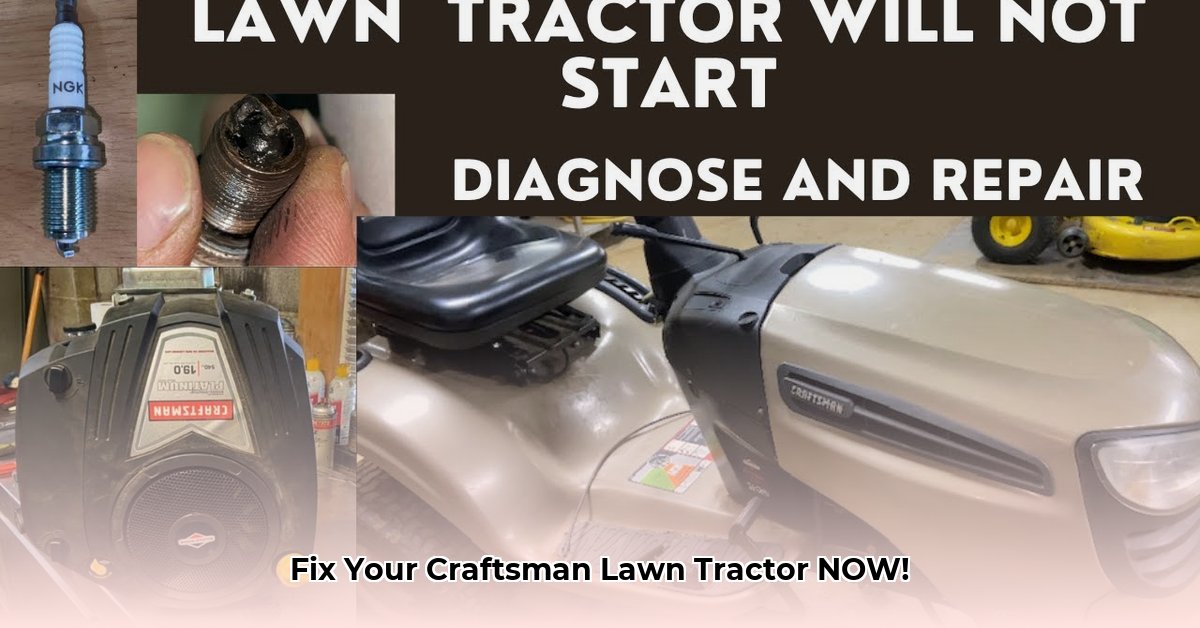
Got a Craftsman lawn tractor that refuses to start? Don't despair! Many starting issues are easily solved with some basic troubleshooting. This guide provides step-by-step instructions to get your mower running again. We'll cover common problems, offer helpful tips, and explain everything in plain English. Let's get you back to mowing! For deck engagement problems, see this helpful guide: Mowing Deck Issues.
Safety First: Always Prioritize Safety
Before you begin any maintenance, disconnect the spark plug wire. This crucial step prevents accidental starts and protects you from serious injury. Never skip this step.
Fuel System: Ensuring Proper Fuel Delivery
Check Fuel Freshness: Old gasoline (more than a month old) is a common culprit. Drain old fuel and refill the tank with fresh, high-quality gasoline. Consider using low-ethanol fuel for improved performance and longevity. (Experts recommend low-ethanol fuel for better engine health.)
Inspect the Fuel Filter: This small component prevents debris from entering the engine. Locate the fuel filter (usually near the fuel tank). If it's dirty or clogged, replace it. This is a quick, inexpensive fix with a high success rate.
Examine Fuel Lines: Carefully inspect fuel lines for cracks, kinks, or leaks. Even a small leak can prevent fuel from reaching the engine. Repair or replace damaged lines immediately; a leaking fuel line is a fire hazard. (Damaged fuel lines should be addressed promptly to prevent spills and potential fires.)
Ignition System: Generating the Spark
Check the Spark Plug: Remove the spark plug (after disconnecting the spark plug wire!). Inspect it for dirt, oil, or damage. Replace a dirty, damaged, or excessively worn spark plug. This is a common and inexpensive fix. (A new spark plug is a cheap and often highly effective solution.)
Inspect the Spark Plug Wire: Check for cracks, fraying, or any damage along the wire connecting the spark plug to the ignition coil. Replace a damaged wire. (A seemingly minor crack can disrupt the electrical connection.)
Test the Ignition Coil (Advanced): Testing the ignition coil requires more advanced knowledge. If you're uncomfortable, consult a professional. (A faulty ignition coil requires specialized testing and might need professional attention.)
Battery Power: Supplying Starting Power
Test Battery Voltage: Use a multimeter to check the battery voltage. A healthy battery should read 12.7 volts or higher. A lower reading indicates a weak or dead battery requiring charging or replacement. (A reading below 12 volts usually points to a battery needing attention.)
Clean Battery Terminals: Corrosion on the battery terminals hinders current flow. Clean them with a wire brush to ensure good electrical contact. This simple step often resolves starting problems.
Replace the Battery (If Necessary): If the voltage is consistently low despite cleaning terminals, replace the battery. (Consider a high-quality battery for improved reliability.)
Air Filter: Maintaining Proper Airflow
Inspect the Air Filter: A clogged air filter restricts airflow to the engine. Locate the air filter and inspect its condition.
Clean or Replace the Air Filter: Clean a reusable air filter or replace a disposable one. A clean air filter is crucial for optimal engine performance. (A clogged air filter significantly reduces engine efficiency.)
Safety Switches: Ensuring Operational Safety
Craftsman lawn tractors often include multiple safety switches (seat switch, blade engagement switch, etc.) that must be properly engaged for the engine to start.
Locate Safety Switches: Consult your owner's manual to identify the location of all safety switches.
Inspect and Test Safety Switches: Carefully test all switches. They often have a simple ON/OFF function. If a switch is faulty, replace it. These are essential safety features. (Disregarding safety switches can lead to unexpected engine operation.)
Troubleshooting Table: Quick Reference Guide
| Problem | Possible Causes | Solutions |
|---|---|---|
| Engine cranks but doesn't start | Fuel issues, spark plug, ignition coil, air filter | Check fuel system, spark plug, ignition coil, air filter |
| Engine doesn't crank | Dead battery, faulty starter, safety switches | Charge/replace battery, check starter, test switches |
| Engine sputters and dies | Fuel issues, air filter, spark plug, ignition coil | Check fuel system, air filter, spark plug, ignition coil |
Preventative Maintenance: Proactive Care
Regular maintenance prevents many starting problems:
- Fresh Fuel: Use fresh gasoline regularly. Avoid storing gasoline for extended periods.
- Oil Changes: Follow the recommended oil change schedule in your owner's manual.
- Air Filter Maintenance: Regularly clean or replace the air filter.
- Winter Storage: Properly store your tractor during winter to prevent damage.
When to Call a Professional: Knowing Your Limits
For complex electrical issues, suspected internal engine damage, or persistent problems after troubleshooting, consult a qualified mechanic or Craftsman repair center. Don't risk further damage by attempting repairs beyond your skill level. (Professional help ensures proper repairs and avoids costly mistakes.)
Key Takeaways:
- Fuel Freshness: Old fuel is a common culprit. Always use fresh fuel.
- Battery Power: A weak battery prevents cranking. Test and maintain your battery.
- Airflow: Clogged air filters restrict airflow. Keep the air filter clean.
- Ignition: Faulty spark plugs or ignition components prevent starting. Inspect the entire ignition system.
- Safety: Ensure all safety switches are properly engaged and functional. They are there for your safety.
This guide provides a comprehensive approach to troubleshooting common Craftsman lawn tractor starting issues. By following these steps, you'll likely get your mower back in working order quickly and safely!